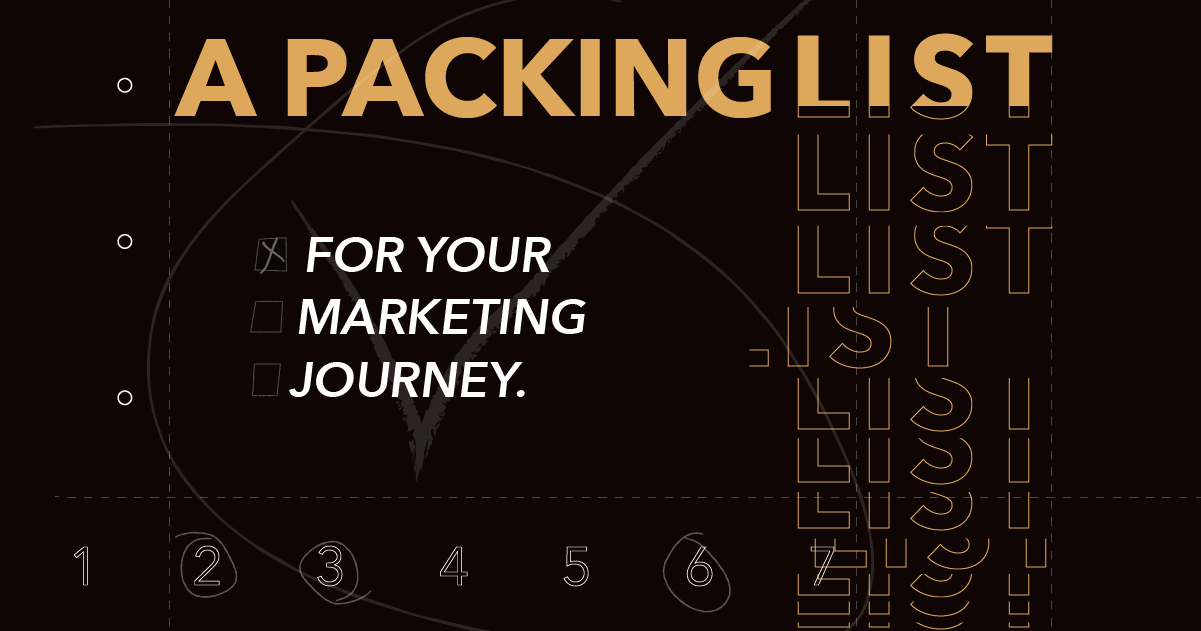
We all know that marketing is important to a business, just like everyone’s dad would say, “You gotta spend money to make money.” What you might not know, however, is how to spend your marketing dollars, who you should target, or how to measure your return on investment. So let’s talk about the packing list of items you’ll need to ensure a successful marketing and advertising journey.
- Business goals
It’s vital to set up well defined and measurable business goals. For example: how many widgets do you want to sell, or how many new email addresses do you need, etc. This goal will drive every other aspect of your strategy, so make sure your internal team understands and is on board.It’s equally important to make sure your business goals are attainable. Do your research, look at previous metrics or efforts to find a solid baseline for success.
- Target audience
Who is most likely to help you reach your goal? Keep in mind, this could be more than one group of people. You could sell multiple widgets that appeal to both millennials and baby boomers. However, it is crucial that you group audiences and then rank them by the level of importance.It’s impossible to be everything to everyone. You can have multiple audience groups you would like to reach but an advertising campaign will likely need to focus on one audience segment. By being as specific as possible in your targeting, the messaging can be more customized and direct, resonating far more with your audience.
- Media Strategy
Once you have identified your target audience (or specific segment if you have multiple target audiences) it is time to learn HOW and WHERE your target audience consumes media.For example, if you want to target millennials, here are a couple of things to consider: most millennials are cord-nevers or cord-cutters, looking into streaming television opportunities could be a good fit. Especially because the video has high brand retention. You may also turn to social platforms where people are spending more time (especially during COVID) to build trust amongst a highly engaged audience.
The most important thing in strategy is reaching the right audience, in the right place with the right message. Having a tailored approach will always yield better immediate results and help build lifelong customers and advocates for your brand.
- Budget
One of the hardest things to determine is how much you should spend on advertising. To be honest, there’s no exact answer but there are a couple things to consider.- If you are trying to drive revenue it needs to fall between 5%-20% of your overall revenue goal. Now, this is a big range and you can skew toward the lower end if you have an established brand and product. If your brand is newer and doesn’t have loyalty in the market or an established audience, you should be skewing towards the high end. It all goes back to the whole “spend money to make money” thing.
- Assigning a cost per lead or cost per action you are willing to pay is a great step. If you are running an awareness campaign or action-oriented campaign, your team needs to determine what a reasonable cost per action would be for your internal purposes. Then you can work back from there to determine a reasonable overall budget.
- There is always the possibility that you have no idea what your budget should be. That is also totally okay. That is why you work with an advertising partner who can do the research and tell you what your audience availability and saturation is to determine what your spend should be. If you are in this boat, I recommend starting in a small geography, fine-tuning a media mix that works and scaling it up from there. Starting slowly at first always sets you up better for success on a larger level.
- Measurement
ROI. KPI. Whatever you want to call it, you won’t know if your advertising is working if you aren’t measuring it.Setting up ways to track your key performance indicators is critical to any successful marketing campaign. While some tactics are easier to measure than others, you can also set up internal tracking measurements. It is important to note, if you are tracking performance via web or digital tactics they have to be set up from the beginning because retroactive data mining isn’t an option (although I definitely wish it was).
As you can tell, setting up the guidelines of your marketing roadmap can seem like a lot of work. Just like anything else, the more you prepare upfront, the more likely you are to enjoy the journey. Or in this case, increase revenue, and who doesn’t love that? If you have a foundation of information but you just don’t have the time to organize it in a meaningful way, drop us a line, Fieldtrip is ready to help!



